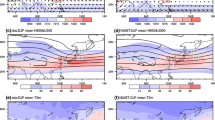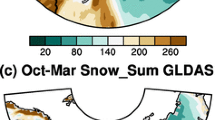Abstract
Several observational and modeling studies indicate that the Indian summer monsoon rainfall (ISMR) is inversely related to the Eurasian snow extent and depth. The other two important surface boundary conditions which influence the ISMR are the Pacific sea surface temperature (SST) to a large extent and the Indian Ocean SST to some extent. In the present study, observed Soviet snow depth data and Indian rainfall data for the period 1951–1994 have been statistically analyzed and results show that 57% of heavy snow events and 24% of light snow events over west Eurasia are followed by deficient and excess ISMR respectively. Out of all the extreme monsoon years, care has been taken to identify those when Eurasian snow was the most dominant surface forcing to influence ISMR. During the years of high(low) Eurasian snow amounts in spring/winter followed by deficient(excess) ISMR, atmospheric fields such as temperature, wind, geopotential height, velocity potential and stream function based on NCEP/NCAR reanalyses have been examined in detail to study the influence of Eurasian snow on the midlatitude circulation regime and hence on the monsoon circulation. Results show that because of the west Eurasian snow anomalies, the midlatitude circulations in winter through spring show significant changes in the upper and lower level wind, geopotential height, velocity potential and stream function fields. Such changes in the large-scale circulation pattern may be interpreted as precursors to weak/strong monsoon circulation and deficient/excess ISMR. The upper level velocity potential difference fields between the high and low snow years indicate that with the advent of spring, the winter anomalous convergence over the Indian region gradually becomes weaker and gives way to anomalous divergence that persists through the summer monsoon season. Also the upper level anomalous divergence centre shifts from over the Northern Hemisphere and equator to the Southern Hemisphere over the Indian Ocean and Australia.








Similar content being viewed by others
References
Bamzai A, Shukla J (1999) Relation between Eurasian snow cover, snow depth and the Indian summer monsoon: an observational study. J Clim 12: 3117–3132
Barnett TP, Dumenil L, Schlese U, Roeckner E, Latif M (1989) The effect of Eurasian snow over on regional and global climate variations. J Atmos Sci 46: 661–685
Chen TC, von Loon H (1987) Interannual variation of the tropical easterly jet. Mon Weather Rev 115: 1739–1759
Corti S, Molteni F, Brankovic C (2000) Predictability of snow depth anomalies over Eurasia and associated circulation patterns. Q J R Meteorol Soc 126: 241–262
Dash SK, Singh GP, Vernekar AD, Shekhar M S (2004) A study on the number of snow days over Eurasia, Indian rainfall and seasonal circulations. Meteorol Atmos Phys 85(1–2):1–13
Dash SK, Singh GP, Shekhar MS, Vernekar AD (2003) Influence of Eurasian snow depth anomaly on the Indian summer monsoon circulation. Mausam 54(2): 427–442
Dickson RR (1984) Eurasian snow cover versus Indian monsoon rainfall – an extension of the Hahn- Shukla results. J Clim Appl Meteorol 23: 171–173
Ferranti L, Molteni F (1999) Ensemble simulations of Eurasian snow-depth anomalies and their influence on the summer Asian monsoon. Q J R Meteorol Soc 125: 2597–2610
Hahn DJ, Shukla J (1976) An apparent relation between Eurasian snow cover and Indian monsoon rainfall. J Atmos Sci 33: 2461–2462
Joseph P V (1978) Sub-tropical westerlies in relation to large-scale failure of Indian monsoon. Indian J Meteorol Hydrol Geophys 29: 412–418
Joseph PV, Mukhopadhyaya RK, Dixit NV, Vaidya DV (1981) Meridional wind index for long range forecasting of Indian summer monsoon rainfall. Mausam 32: 31–34
Kalnay E, Kanamitsu M, Kistler R, Collins W, Deaven D, Gandin J, Iredell M, Saha S, White G, Wollen J, Zhu Y, Chelliah M, Ebisuzaki W, Higgins W, Janowiak J, Mo KC, Ropelewski C, Wang J, Leetmaa A, Reynolds R, Jenne R, Joseph D, (1996) The NCEP/NCAR 40-year Reanalysis Project. Bull Am Meteorol Soc 77: 437–471
Kiladis GN, Diaz HF (1989) Global climate anomalies associated with extremes in the Southern Oscillation J Clim 2: 1069–1090
Kripalani RH, Kulkarni A (1999) Climatology and variability of historical Soviet snow depth data: some new perspectives in snow – Indian monsoon teleconnection. Clim Dyn 15: 475–489
Kripalani RH, Singh SV, Vernekar AD, Thapliyal V (1996) Empirical study on Numbus-7 snow mass and Indian summer monsoon rainfall. Int J Clim 16: 23–34
Krishnamurti TN (1972) Tropical east-west ciculations during the northern summer. J Clim 28: 1342–1347
Krishnan R, Mujumdar M (1999) Remotely and regionally forced pre-monsoon signals over northern India and neighbourhood. Q J R Meteorol Soc 125: 55–78
National Snow and Ice Data Center (1999) Historical Soviet Daily Snow Depth version-II, Cooperative Institute for Research in Environmental Sciences, University of Colorado, Boulder, USA
Parthasarathy B, Munot A, Kothawale DR (1995) Monthly and seasonal rainfall series for All India. Re RR-065: 113, Indian Institute of Tropical Meteorology, Pune, India
Rajeevan M (1993) Upper tropospheric circulation and thermal anomalies over central Asia associated with major drought and floods in India. Current Sci 64: 244–247
Sankar-Rao M, Lau MK, Yang S (1996) On the relationship between Eurasian snow cover and the Asian summer monsoon. Int J Climatol 16: 605–616
Soman JK, Slingo J (1997) Sensitivity of Asian summer monsoon to aspects of sea surface temperature anomalies in the tropical Pacific Ocean. Q J R Meteorol Soc 123: 309–336
Vernekar AD, Zhou J, Shukla J (1995) The effect of Eurasian snow cover on the Indian monsoon. J Clim 8: 248–266
Acknowledgements
Some of the results presented in the paper are obtained from the projects sponsored by the National Science Foundation, USA and the Department of Science and Technology, Government of India. The monthly snow depth data for the period 1881 to 1995 have been obtained from the NSIDC on CD-ROM. The atmospheric fields for the period 1948 to 1994 were obtained from the NCEP/NCAR reanalyzed data CDs. Indian Summer Monsoon Rainfall data have been taken from Parthasarathy et al. (1995) based on observed rainfall data of the India Meteorological Department.
Author information
Authors and Affiliations
Corresponding author
Rights and permissions
About this article
Cite this article
Dash, S.K., Singh, G.P., Shekhar, M.S. et al. Response of the Indian summer monsoon circulation and rainfall to seasonal snow depth anomaly over Eurasia. Clim Dyn 24, 1–10 (2005). https://doi.org/10.1007/s00382-004-0448-3
Received:
Accepted:
Published:
Issue Date:
DOI: https://doi.org/10.1007/s00382-004-0448-3




